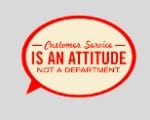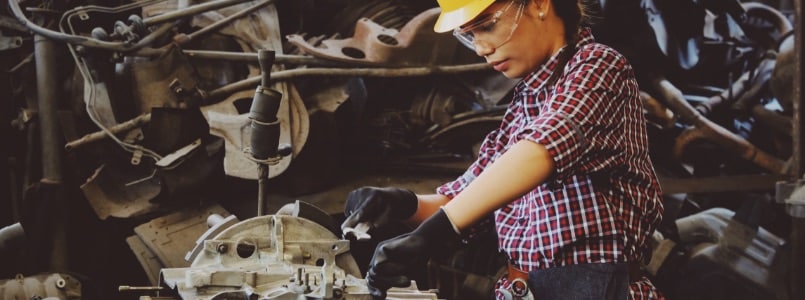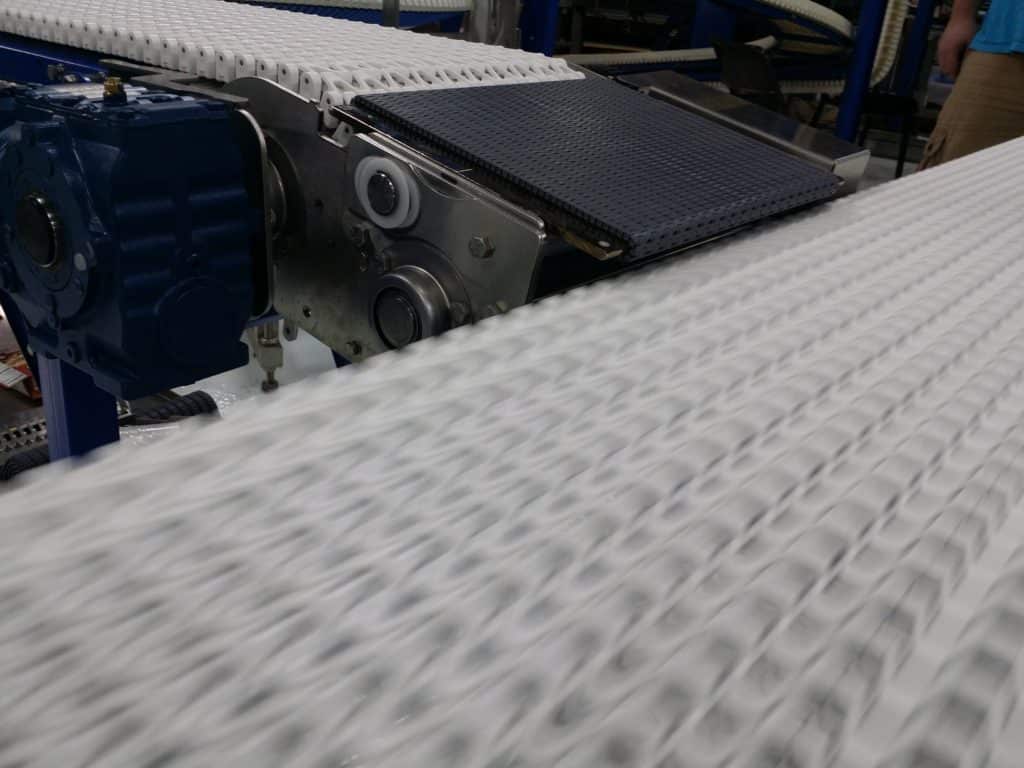
1. Poor Customer Service
Think back to the last time you had a negative experience with a store. Maybe you had a question none of the employees could answer. Perhaps you called and were transferred from person to person before getting the assistance you needed. Or, maybe you were made to feel like you were an afterthought and your business wasn’t valued. Sadly, it’s safe to say most people have witnessed poor customer service like this. When you work in the manufacturing industry, experiencing this sort of situation can be detrimental. From receiving incorrect parts on an order to wasting company time on the phone with a representative, poor customer service can severely hurt your business. No matter how great their products might be, companies who treat you this way are sure to lose you as a returning customer.

2. Adequate Customer Service
At Span Tech, we have a saying: “Just enough is never enough.” Sure, adequate customer service is fine, but it only gets consumers so far. How many times have you faced a problem, been assisted by a representative and had your needs met…but only just? While this type of experience will help your business for the time being, it won’t necessarily provide long-term benefits. For example, let’s say you ask a representative a question about a product, and they provide you with an answer. They’ve done their job, the phone call ends and you continue on with your day. While things seem fine on the surface, adequate customer service like this ultimately lacks two things: time and energy. The representative hasn’t made an effort to learn about your manufacturing business, the role their company plays in assisting you or how they can help you succeed.
As a manufacturer, it’s important to focus on the big picture of your company. A big part of that involves having a supplier who understands your challenges, goals and overall mission. As the name suggests, adequate customer service falls short of achieving this for your business.
3. Excellent Customer Service
It’s great when things go right, but excellent customer service does so much more than that. This form of assistance goes above and beyond, while both meeting and surpassing expectations. If you’re one of the lucky ones, you know exactly what this looks like — a kind, helpful, positive interaction that kept your business on the right track.

Ultimately, excellent customer service leaves you feeling listened to, assisted and, above all, valued. It’s exactly what you can expect from the Span Tech team. From the moment you make the first phone call or walk through our doors, you’ll be met with a friendly voice or smile and a genuine desire to serve your business. We believe in serving our customers before, during and after their requirements are met. It’s the sort of treatment you deserve, and we wouldn’t have it any other way.
Get Unparalleled Customer Service From Span Tech
At Span Tech, you come first, and you always will. We make it our mission to provide our customers with the utmost professional, helpful, and highest quality they deserve during their experience with us. Our goal is to provide timely, attentive, upbeat service to our customers, to make sure their needs are met in a manner that reflects positively on the company. Whether you’re interested in our standard conveyors, experiencing troubleshooting or are curious about our case studies, we’re here to go above and beyond. Contact us today to learn more about our services and what Span Tech can do for your manufacturing business!
Span Tech & PACK EXPO
As a proud industry leader, Span Tech specializes in building durably designed plastic chain conveyors and industry-leading innovation material. We’re passionate about developing unique, customizable technical solutions for a variety of industries to meet their individual needs. With an emphasis on quality and state-of-the-art manufacturing, we’re always staying up to date on the latest in the industry. That’s where PACK EXPO comes into play.
For more than 60 years, PACK EXPO trade shows have been helping a variety of industries advance by connecting consumer goods companies with manufacturing solutions. At Span Tech, we look forward to attending this trade show every year to connect with manufacturers, promote our services and discover the latest innovations in packaging.
PACK EXPO 2019 was held in Las Vegas and received a record turnout of 30,000 packaging professionals and 2,000 of the industry’s top suppliers. Like many other events in 2020, however, this tradeshow will be a bit different as we take proper precautions in light of COVID-19.
2020’s PACK EXPO Connects
Rather than host an in-person PACK EXPO, The Association for Packaging and Processing Technologies (PMMI), has decided to make it virtual. Also known as PACK EXPO Connects, the virtual PACK EXPO will be live and web-based. Hosting this event virtually will help prevent the spread of COVID-19 and make PACK EXPO more accessible than ever before.
Taking place from Nov. 9-13, PACK EXPO Connects will feature live chats, live equipment demos and engaging educational opportunities. Attendees can expect to see machinery up close and in action through world-class opportunities. From daily jumpstart sessions on hot topics to expert-led education sessions, PACK EXPO 2020 is full of exciting virtual sessions for attendees to benefit from.
Span Tech Demos at PACK EXPO Connects
This year, Span Tech is more excited than ever to be a part of PACK EXPO. We’re hosting a variety of demos featuring some of our top products and key industry tips to help your manufacturing processes. Best of all, when you join any of our live sessions, you’ll be entered to win a $250 Amazon gift card! We’ve listed our demos in chronological order below so you can be sure not to miss them.
Nov. 9: All Things Elevation
From lifting to lowering, our systems change elevation while keeping your product in top shape. No matter what height or depth your product needs to reach, we have the solution that will maximize uptime and ROI. In this demo, we will be talking about all the different solutions that we have for inclining and declining your products.
Products featured in this demo include:
- Topper Lift
- Helical Curve
- Outrunner Spiral
- Wedge Unit
- Incline & Decline Conveyors
Demo Schedule: Monday, Nov. 9 from 1:45 PM – 2:00 PM CST
Nov. 11: New Product – EZ Guide Adjustable Guide Rail
Bud Layne, owner of Span Tech LLC, will review and demonstrate the new EZ Guide adjustable guide rail system. This system is a new design which has never been seen before in the marketplace and can solve many of the primary issues that other guide rail systems have. In this session, Bud will show off these features and give a live demonstration of the prototype unit that has been built. You won’t want to miss this as we revolutionize the complications of conveyor guide rails.
Demo Schedule: Wednesday, Nov. 11 from 2:00 PM -2:15 PM CST
Nov. 12: I Wanna Get Technical… Technical
This demonstration will go over several Span Tech products and discuss some of the more technical aspects of what they do, how they work, how they are unique in the market and what advantages they provide.
Products featured in this demo include:
- Topper Lift
- High-Speed Switch
- Cageless Spiral
- Standard Conveyors
Demo Schedule: Thursday, Nov. 12 from 12:45 PM -1:00 PM CST
Nov. 13: Product Manipulation
Don’t you hate it when your product comes out of the machine in the wrong orientation? Well, we can help with that. Whether you need rotation, a roll over or flipping, we can do it all! Check out our Product Manipulation demo and see how we can help you get your product in the right orientation precisely when you need it.
Products featured in this demo include:
Demo Schedule: Friday Nov. 13 from 10:15 AM -10:30 AM CST
Don’t Miss Out On Span Tech’s Demos at PACK EXPO Connects
At Span Tech, we recognize the value in manufacturing technology and putting you first. We’re proud to be a part of PACK EXPO Connects, and we look forward to connecting with you and showing you our latest developments. If you wish to learn more about registering for our demos or have other questions about PACK EXPO 2020, reach out to us today!
A Closer Look at The Span Tech Conveyor Design
Before we dive into talking about conveyors, it’s important to distinguish the difference between our modular plastic conveyor chain and the commonly used phrase “conveyor belt.” Often confused as one in the same, the two are quite different. Just as the name suggests, a conveyor “belt” is just that — a belt. It’s a continuous, flat loop of fabric or plastic that transports products in a straight line (with very few exceptions.) Our modular plastic conveyor chain is different than a belt in that it is built from individual interconnecting rows of chain. This type of design can be made to a wide variety of widths and lengths depending on the needs of the application. Additionally, because these rows can collapse with each other, our modular chain has the ability to make curved, twisting, inclining and declining conveyors.
Modular Conveyor Parts and Functions
To get a better understanding of how our modular plastic conveyor chains work, it’s important to know how their parts function together. Span Tech’s unique conveyor design is made up of the following pieces:
Chain
The chain on our modular conveyor is what carries the product from one end to another. Our plastic chain conveyor types are customized for each order and can be made in thousands of variations. They can travel through curves, twists, inclines, declines and more, and they are extremely strong yet flexible.
Drive Unit
The drive unit is what pulls the plastic chain to help keep it in motion. It contains the conveyor’s drive sprockets, drive shaft and gearmotor. Drive units can be located at either end of our modular conveyor or even in the middle.
Idler Unit
Similar to the drive unit in appearance, the idler unit is found at both ends of the modular plastic conveyor chain. Unlike the drive unit, it doesn’t provide power. Instead, it allows the chain to move from the top to the bottom of the conveyor.
Bed Section
Located between the drive and idler units, the bed section is made of a side frame and wear strips. These strips capture the modular plastic conveyor chain and provide a low-friction running surface for it. Bed sections can be straight, curved, angled up or down, twisted or custom-made for just about any special application.
How Does a Modular Conveyor Chain Work?
It’s time we let you in on a little secret: Not all conveyors are created equal. Compared to all the different types of conveyors out there, Span Tech’s modular conveyors offer many unique features that help them stand out. Along with a distinct conveyor design, our products prove to be a cut above the rest with the following qualities:
No Chain Take Up
Thanks to our conveyor design, there is no need for a “catenary,” or chain take up section, to maintain chain tension in the system. All conveyors expand over time, and the total chain length may need to be shortened as a result. While this can be a bit of a hassle with other types of conveyors on the market, Span Tech conveyors are fairly simple to accommodate. Simply remove one or two rows of chain from the system, and you’re good to go. It’s that easy!
Individual Links
Unlike many other types of conveyors, Span Tech’s use individual links to make up the chain. This makes maintenance fairly easy and stress free if you ever have an issue. Rather than replace the entire modular plastic conveyor chain, you can simply repair the necessary parts. You’ll ultimately save money and be spared the headache that comes with investing in a brand new conveyor.
No Tracking Issues
Traditional belts require a system to keep the belt aligned and prevent it from “walking” off of the pulley. In comparison, Span Tech modular plastic conveyor chains don’t need this set up. Why? Our chains are kept in place within the bed section along the entire path of travel. The chain’s sprockets also keep the chain from traveling off of the drive unit.
No Black Residue Buildup
Quite often, a black residue can form after stainless steel rubs against certain plastics. This can leave items passing through the belt looking dirty and unsightly. You’ll never have to worry about this with our modular plastic conveyor chains. Span Tech’s stainless steel rods use a proprietary coating which prevents rubbing and eliminates black residue buildup.
Get A Top-Quality, Customized Conveyor Design from Span Tech
Since 1988, we’ve made it our mission to provide premium-quality modular conveyors for manufacturers and distributors. At Span Tech, we’re proud to offer the tightest turning radius for modular chain conveyors in the industry. Beyond that, we’re committed to providing our customers with unparalleled service and 24/7 support. Reach out to our staff to learn more about our standard straight, standard curving and speciality conveyors!

Span Tech’s Conveyor Safety Rules
According to the United States Department of Labor, conveyors are the primary source of more than 50 workplace fatalities each year. In the unfortunate event that your staff members get injured (or worse) on the job, your company can face legal issues, worker’s comp and other liabilities. Not to mention, your plant can lose out on valuable production time. The best way to keep your team free from harm is by practicing conveyor safety. The Span Tech experts are here to help keep your staff injury-free with the following conveyor safety tips for manufacturing plants.
1. Don’t Sit, Stand or Walk on Conveyors
While this first conveyor safety rule may seem like common sense, it can lead to serious injury if it isn’t followed. People ride conveyors because they don’t realize just how grave the danger can be. Whether they’ve seen it in action movies or they just think it sounds fun, the reality of riding a conveyor is quite unsafe. The main reasoning behind this is because conveyors aren’t designed to hold a human’s weight. They also have pinch points which can catch onto people and cause injuries. Additionally, when people ride conveyors, they can cause the belts to un-track or damage the system. As a result, it’s imperative that your staff never climbs, sits, stands, walks, rides or touches the conveyor line.
2. Refrain from Modifying or Misusing Conveyor Controls
Unqualified personnel should never attempt to modify or disconnect conveyor controls. When this happens, it can create a less safe working environment and put your team at risk. Conveyor controls are part of a larger system, so any changes should be approved by management. Be sure to monitor your controls to ensure no staff member has misused, modified or disconnected them.
3. Follow Lock Out, Tag Out (LOTO) Procedures
LOTO is a very important procedure used in manufacturing settings. It involves making sure dangerous machines like conveyors are properly shut off and not able to be started up again before maintenance is completed. If you fail to do this, your employees are subject to life-threatening injuries. To help your team follow this conveyor safety rule, we recommend appropriately training them and explaining its importance.
4. Keep Loose Items Away From Conveyors
From watches and rings to baggy clothing, it’s crucial for your team to avoid wearing loose items on the job. Pinch points can catch loose items if they’re worn near a conveyor, resulting in serious injury. A great way to implement this conveyor safety rule is to inspect staff members before allowing them near the conveyor line.
5. Alert Management of Any Potential Safety Concerns
If your employees notice a potential hazard on the job, it’s crucial for them to inform management so the issue can be resolved. The main goal should always be to spot and deal with unsafe practices, equipment or people as soon as possible. Employees will be more likely to come forward if you allow them to provide anonymous or non-consequential information submissions.
6. Utilize OSHA Emergency Stops
According to the Occupational Safety and Health Administration (OSHA), emergency stop requirements for safe conveyor operations are as follows:
- Means for stopping the motor or engine shall be provided at the operator’s station. Conveyor systems shall be equipped with an audible warning signal to be sounded immediately before starting up the conveyor.
- If the operator’s station is at a remote point, similar provisions for stopping the motor or engine shall be provided at the motor or engine location.
- Emergency stop switches shall be arranged so that the conveyor cannot be started again until the actuating stop switch has been reset to running or “on” position.
7. Make Conveyor Safety Training a Priority
Reviewing our conveyor safety rules with your team will help them avoid injuries on the job and keep your plant running smoothly. Provide frequent updates and refresher courses to ensure your employees know the latest on conveyor safety. Whenever your plant has visitors, they should always be informed of conveyor safety standards, as well. Above all, make the notion of preventing unsafe acts part of your company culture.
Learn More About Conveyor Safety Rules with Span Tech
One of the most important goals for any warehouse is to keep your workers safe. Conveyor use is vital, but it shouldn’t put them at risk of getting injured. Since our founding in 1988, Span Tech has been committed to helping your team work efficiently and stay out of harm’s way. We’re proud to offer a variety of premium conveyors designed with your staff’s safety in mind. To discover more about conveyor safety or our selection, contact us today!
We’re proud to bring you the best possible products to help you implement good manufacturing practices and ensure pharmaceutical quality. Reach out to our staff today to learn about our custom conveyors and start your estimate!

1. Eliminate Downtime
As the saying goes, “Time is money.” The last thing your team needs is to pause their work due to machine failure. When you have spare parts on hand in your plant, any downtime caused by faulty equipment is practically eliminated. Why? Because you can instantly replace any pieces you need and get back to work. This creates an efficient, productive work environment for your employees and helps you ensure satisfaction for your customers.
The biggest struggle in spare part management is creating an inventory. Span Tech’s spare parts department can help you compile a list of recommended spare parts to put together for your actual conveyors.
2. Increase Effectiveness
No business is immune from bumps in the road. When push comes to shove, your team can either be proactive or reactive. A strictly reactive manufacturing plant must take the time and effort to deal with any issue that arises. This can cause you to waste a lot of energy on problem solving rather than thinking about the bigger picture for your business. Most manufacturers are historically known for being reactive to events like equipment failure.
On the other hand, a proactive manufacturing plant has solutions to those problems before they even occur. One of the best ways to foresee and diminish obstacles your plant may have is by keeping replacement parts on hand.
In order to successfully create a functional spare part inventory, you need a more predictive approach to machine maintenance and failure. To do this, it’s important to note a collection of past purchase orders and overnight shipments. What parts were used? What’s your current inventory of those parts? Span Tech keeps this information on hand and can analyze the data, giving you the ability to see which items should be on hand at all times.
Get Spare Manufacturing Inventory from Span Tech
Since 1988, Span Tech has strived to exceed expectations and satisfy our customers. From specialty conveyors to spare manufacturing parts, we make it our mission to give you the very best. To order spare inventory for your facility, contact our Spare Parts team today!

GMP Meaning
If you’re in the pharmaceutical industry, odds are you’ve heard the acronym “GMP” before. But do you know what it means? GMP stands for good manufacturing practices. It’s a term used interchangeably with CGMP, which means current good manufacturing practices. The Food and Drug Administration (FDA) uses these practices to regulate and ensure pharmaceutical quality, as well as quality in other industries like cosmetics and food production.
Why is GMP Important in the Pharmaceutical Industry?
From monitoring proper design to controlling facility processes, good manufacturing practices are an essential part of the pharmaceutical industry. CGMP regulations require medicine manufacturers to adequately control their operations. By following these regulations, pharmaceutical companies ensure the drug products’ identity, strength, quality and purity.
When your pharmaceutical company follows these practices, you can avoid many of the most common causes of quality failure like drug contamination, deviations or mix-ups. Consumers typically can’t detect that a drug is safe or if it will work, so it’s crucial to manufacturing pharmaceutical products under the conditions and practices mandated by CGMP. Continue reading to discover some of the best manufacturing practices to follow to assure the safety and efficacy of your pharmaceutical products.
Proper Research & Development
In the pharmaceutical industry, extensive research and development are incredibly important. Good manufacturing practices mandate that scientists conduct thorough studies to determine which drugs to develop. Thousands of tests must take place in labs to conclude if the drugs will work.
All drugs must undergo a clinical trial. Results from trials and testing are used for further development. This helps ensure top pharmaceutical quality.
Pharmaceutical Quality Assurance & Control
Quality assurance and control play a major role in good manufacturing practices. They ensure that the necessary and relevant tests are carried out and pharmaceutical products aren’t released until deemed satisfactory. Pharmaceutical quality and assurance can be achieved through tactics such as:
- Conducting monitored testing and sampling
- Setting strict rules and specifications for all employees to follow
- Keeping tools and ingredients as organized as possible
- Documenting and recording procedures
Detailed Analysis of Manufacturing Processes
For ultimate quality and reliability, the manufacturing process for pharmaceutical products must be consistent and repeatable. Even the slightest change in a drug’s composition can have life-threatening effects on users.
To help avoid risk, your organization must analyze its manufacturing process and define strict, cohesive methods to follow. In doing this, you’ll ensure that every product is made in accordance within predefined specifications and that each batch is consistent and safe to administer.
If any changes occur when creating the product, it should be analyzed closely and checked for pharmaceutical quality. Any products losing quality as a result of these alterations are classified as contaminated and should be discarded.
Complete Inventory Visibility
The way your team stores and transports products to different channels is important. Complete downstream inventory visibility will help you implement good manufacturing practices like:
- Saving time when compiling shipments
- Monitoring inventory levels
- Prioritizing safety measures
- Continuously improving the supply chain
Premium Equipment
Success in the pharmaceutical industry is impossible without proper manufacturing tools and equipment. Along with selecting the right warehouse, you need machinery designed for effective cleaning and the prevention of cross-contamination. Having the proper equipment will also help you safely transport items like vials, bottles, bags, tubes, small cartons and more. In compliance with CGMP, each piece of machinery must be validated and calibrated and have procedures, schedules and records.
Implement Good Manufacturing Practices with Custom Conveyors from Span Tech
Span Tech is no stranger to manufacturing in the pharmaceutical industry. Since 1988, we’ve been bringing you, premium-quality pharmaceutical conveyors, for manufacturers and distributors. Our conveyor solutions feature:
- High-speed palletizing
- Break pack picking using in-voice and RF picking technology
- Solutions for tracking and logging all movement
- High-speed sortation systems
We’re proud to bring you the best possible products to help you implement good manufacturing practices and ensure pharmaceutical quality. Reach out to our staff today to learn about our custom conveyors and start your estimate!

Mechanical Testing
Conveyors are mechanical assemblies, so it’s not surprising that most of the testing we perform is mechanical in nature. We need to understand the limits of what our products can actually do. We perform these tests to answer questions like:
- How strong will it be?
- How long will it last?
- What, when, and how is it likely to break?
To get these answers, we use a variety of tools and setups. We have a tensile testing machine to determine the strength of our chain links. This will not only tell us how much a chain-link can pull (ultimate strength test), but we can also use this device to predict how long the link will last under fatigue conditions. This machine will literally push/pull on a link for millions of cycles until it breaks. The data derived from these tests allow us to understand how to design better conveyor solutions for our clients.
Not only can we perform strength and fatigue testing on a single element (chain link), we can also do large-scale testing of entire conveyor setups. We have an extremely powerful Gearmotor/torque transducer setup which allows us to measure the amount of pull a conveyor is capable of with extreme loads. We’ve also done several tests using this equipment to determine how conveyors will wear out and eventually be destroyed under adverse conditions.
Tribology (Friction and Abrasion) Testing
We’re often asked: “What’s the steepest angle of incline/decline that your conveyors can do?” The answer is not as straightforward as most might think. The amount of angle for an inclining or declining conveyor depends on many factors, but the most important one is the amount of friction between the customer’s product and our conveyor chain. Even though there are scientific sources that tell us the coefficient of friction for many different materials, we go the extra step and do our own testing using a wide variety of materials to guarantee that we can do the angles that we state.
The materials that we use for our high-friction chain links are quite soft and compliant, and thus – very “grippy.” We can incline and decline some products as much as 25 degrees. However, like the tires on your car, the tradeoff for high-friction results in lowered wear capabilities. That’s why we have also done extensive testing to determine a scale for the durability of the various materials that we use for our chain links.
Thermal, Chemical, and Other Testing
Our conveyors are used in a wide variety of applications. From freezers to bread proofers, we’re dedicated to offering products that can work in a large range of environmental conditions. Additionally, since many of our components rub against one another, heat buildup is also a factor that plays into this.
We test all of our products under various operating conditions to make sure that we understand the limits of what is possible with the materials we use. We use a variety of measuring devices such as thermocouples and infrared cameras and detectors to measure the temperature of our conveyor parts under various operating conditions. We have also been known to do less-scientific tests just to see what happens when we venture outside the normal operating range of these materials (yes, that means we light these things on fire.)
We consider chemical compatibility, as well, since our conveyors are put into a wide range of industries – many with very caustic cleaning agents. In cases where we don’t have established scientific information on chemical compatibility with our materials, we often perform our own in-house tests to make sure that the materials we use will hold up in the environments our customers require.
But we’re not limited to the types of testing already covered. We also have the capability to do sound level testing, plus a wide variety of product tests that we set up and perform exclusively for some of our potential projects. For example, many customers want assurance that a particular solution will work with their specific product. We very frequently configure conveyors, transfers, pushers and all sorts of other devices at our disposal to show a customer that a proposed solution will work – by actually doing it with their actual product.
Get Premium Conveyor Solutions from Span Tech
Since 1988, Span Tech has committed to providing top quality products that exceed expectations and satisfy our customers. The proof is in our innovative ideas, expert staff and thorough capability testing. Reach out to our staff today to learn about our custom conveyors and get started with your estimate today!

Quality: A Shared Responsibility
It’s safe to say that Span Tech isn’t like other companies on the market, and that’s the way we like it. Since our humble beginnings in 1988, quality has always been of the utmost importance in everything we do. Over the years, we’ve learned something crucial: Quality is more about people than it is about things.
This powerful lesson inspired us to thoroughly examine Span Tech’s process. In doing this, we reviewed the way our team collaborates and studied the domino effect each role has on the next. This led us to reevaluate the way we work and how our quality is monitored. We analyzed everything from our account managers communicating with customers to the packing and invoicing of our final products. Our in-depth assessment led us to create Span Tech’s quality approach.
Quality Policy
Span Tech’s quality policy holds all of our employees accountable for the value of their work. Rather than having one quality department keeping tabs on our progress, we assign the responsibility to each and every staff member on our team. Our quality policy states:
“It is the policy of Span Tech to fully understand the requirements of our customers, both internal and external, and to provide defect-free products and services on time.
Quality, continual improvement and customer satisfaction are the personal responsibilities of each and every team member.”
This approach improves the way we work together and the overall satisfaction of our customers. To give you a better understanding of how it works and why it’s effective, we’ve broken down our quality policy’s key points.
Span Tech’s 6 Quality Principles
Our quality policy mandates each of our employees to take ownership and responsibility of their work and to understand the requirements of each task involved in their job. In order to produce quality work and serve our customers with the highest quality products, we abide by the following principles:
1. Personnel
We’re committed to having the right people in the right positions. We ensure this through seeking out employees with prior training, experience and the necessary qualifications. We assess each individual’s skills and talents and place them in roles where they can best utilize those attributes.
2. Relationships
Span Tech expects defect-free products from our suppliers. If we receive items from our suppliers that do not meet our requirements, we provide feedback on corrective action.
3. Technology
As the leading innovator of conveyor solutions, Span Tech utilizes state of the art technology to engineer and manufacture our products.
4. Documentation
Our team ensures documented work instructions and procedures are clearly defined. Whether it’s explaining a job role or an engineering project, the documentation must be accurate, coherent and consistent with Span Tech’s methodology.
5. Verification
We’re committed to ensuring the products we make perform the way they should. As a result, we use appropriate measuring tools to verify dimensions and functional testing. Every Span Tech product must meet our standards, and quality helps us ensure that it does.
6. Dedication
The heart and soul of Span Tech lies within our employees. Their unwavering commitment to doing things the right way and performing their very best ensures the final touch of quality in all of our products.
Quality in Action
It’s one thing to define a policy. But how does Span Tech’s quality initiative impact our day-to-day business? We take a look at how this policy directly affects our team and the measures we’re taking to strive for excellence.
Practicing Prevention
Our team recognizes quality doesn’t simply occur on a whim. We take deliberate actions to avoid defects in our work. To do this, we start with defining our customers’ requirements. We then ensure our procedures for each project are accurate, correct, easy-to-understand and always followed. We also verify that we’re using the proper equipment and everything is functioning properly. By working proactively, we eliminate many risks from the get-go.
Corrective Action & Control of Nonconforming Products
We realize no one is perfect. As a result, mistakes and unforeseen issues may occur. If this happens, our team is dedicated to catching, controlling and correcting any nonconforming product. In doing this, we:
- Identify the product in question.
- Separate it from our other products.
- Rework, repair, return or scrap it.
- Examine what went wrong to prevent the issue from recurring.
Problem Elimination
After a problem is identified, it can often feel impossible to ensure it doesn’t happen again. But when the same problems occur again and again, they can greatly affect morale and waste a lot of valuable time. To eliminate problems, our team works to strategically:
- Define the situation.
- Identify the root cause.
- Determine the best solution.
- Implement changes.
- Verify results.
Making Certain
We’re big fans of fully understanding everything within our work environment. Our employees are empowered to constantly seek clarity and challenge any situation. Whether it’s an oversight, a task with unclear requirements or a general lack of understanding, our team is authorized and encouraged to dig deeper. With certainty comes quality. And, we believe, with quality comes success.
Choose Span Tech for Unparalleled Service and Utmost Quality
Since 1988, Span Tech has been building the very best conveyor systems on the market. While we continue to manufacture premium products, we’re doing everything in our power to minimize error and maximize satisfaction. Providing you with quality is just another way we OUTLAST, OUTPERFORM AND OUTDELIVER.
The Span Tech team is committed to open communication, a solid foundation of trust and a deep appreciation of our customers. When you choose to work with us, you choose an upstanding company that believes in doing the right thing and giving you the best possible product and service around. Reach out to our staff today to learn about our custom conveyors and experience quality in action!
An Introduction to Good Manufacturing Practices in the Food Industry

In the world of manufacturing food, following hygiene and quality protocol is vital to having market success and maintaining consumer safety. Any breach of food safety sanitation requirements can cause serious problems. Companies may face:
- Massive cost penalties
- Criminal prosecution
- Production plant closure
- Damage to their brand’s image
- Business Closure
That’s where Good Manufacturing Practices (GMP) come into play. The use of GMP in the food industry is the best way for a manufacturing plant to prevent these protocol violations from happening and maintain a successful business.
What is Food Safety?
According to the U.S. Food and Drug Administration, the food safety movement is a shift in focus from responding to foodborne illnesses to instead preventing them — to be proactive rather than reactive.
The Food Safety Modernization Act was inspired by changes in the global food system and foodborne illness research. It focuses on battling public health problems and threats to the economic well-being of the food system. Food safety is seen as an efficient way to decrease the risk of contamination and abide by the highest food standards available.
What’s the best way to conduct food safety in manufacturing? Our experts have put together a list of good manufacturing practices in the food industry, along with how to apply them in your facility.
1. Pick the Right Location for Your Warehouse
Location, location, location. It’s not just a mantra for real estate. The location of your manufacturing facility can have a major impact on overall food production safety. We explore the importance of finding just the right spot for manufacturing food in this section.
When food is manufactured, it’s no secret that how it’s made is a crucial part of the process. But where it’s made can be just as important. Certain areas and setups are more qualified for manufacturing food than others. If you don’t choose a place carefully, the food can become contaminated. You can avoid this if you know what to look for during the site selection process for your warehouse. Make sure the building you use is durable, easy to clean and safe for your staff.
You also want to keep an eye out for areas known as pest “hot spots,” which are prone to pollution and troublesome critters like insects and rodents. At nearly any stage of the food manufacturing process, cockroaches and flies can cause contamination and food-borne illnesses. If rats and mice find their way into your warehouse, they can damage fixtures and machinery, and they may ultimately spread diseases.
You can prevent this from happening by researching the area and investing in a pest control monitoring system for your warehouse. Abiding by these food safety standards can make a big difference in your company’s success.
2. Maintain a Clean Work Environment
Practicing proper hygiene is a major food safety sanitation requirement. Discover how cleaning and disinfecting your warehouse can impact your manufacturing process.
It may seem like common sense, but cleanliness is crucial when it comes to food production safety. This means preparation areas, machines and devices must be properly cleaned and disinfected before using them again. Sanitizing the devices used for manufacturing food helps eliminate harmful microorganisms that can cause food poisoning.
But the cleanliness shouldn’t stop there. It’s important to provide your employees with suitable containers and waste storage areas. Make sure these areas are far from any food or machinery. You can take the food production safety one step further by having procedures your staff must follow for storage and waste removal. Following these food safety standards will help you reduce the risk of ingredients, equipment and food products becoming contaminated.
3. Execute a Smart Production Flow
What’s the best way to get a manufacturing job done? The smart way. Find out how a more efficient system can enhance food production safety in this section.
We realize the process of manufacturing food isn’t just about the food – it’s also about your team. This method of GMP in the food industry is a “win” for both the company and the workers, too. It involves decreasing safety hazards that might occur on the job and providing a more secure workplace for your employees. One way to go about this food production safety practice is to examine the manufacturing process. Are there instances that are slowing your team down? Better yet, is anything occurring that could be unsafe as they work? Make note of anything that stands out and how it could be improved. Look for opportunities that decrease lag time and minimize your team’s contact with the product itself.
By implementing this GMP in food safety, your team will have an easier, safer work environment and your product will be manufactured better and quicker. Win-win!
4. Use State-of-the-Art-Machinery
Your product is only as good as your machinery. That’s why it’s important to never cut corners when it comes to manufacturing food. We take a look at how the right machinery can impact your production process in this section.
The machinery you use for manufacturing food can make or break everything. If it’s poorly designed or outdated, your company can face endless setbacks. Excess food particles that are hard to clean, contamination in the manufacturing process, lack of sanitation — the list goes on.
To combat this and illustrate what to look for in machinery for manufacturing food, The American Meat Institute’s Equipment Design Task Force developed the following 10 principles:
- Machinery must be cleanable to a microbiological level.
- Compatible materials should make up the machinery’s design.
- Machinery must be accessible for inspection, maintenance, cleaning and sanitation.
- There should never be leftover product or liquid collection.
- Hollow areas must be hermetically sealed.
- No niches.
- The operation performance of the machinery must be sanitary.
- Maintenance enclosures must be of hygienic design.
- Machinery must have hygienic compatibility with other plant systems.
- The overall manufacturing process should follow cleaning and sanitizing protocols.
When your warehouse abides by these food production safety standards, you set the precedent for happy customers, valued co-workers and a thriving business.
Apply GMP in the Food Industry with Help From Span Tech
With advanced machinery, premium control systems and these manufacturing safety tips, your business can flourish and continue to grow in the competitive food industry. With years of experience and passion for food safety in manufacturing, the Span Tech experts are here to help.
The food production industry can be challenging, but it’s no match for the Span Tech experts. With years of experience and a passion for food production safety, we’re here to help. Our specialty conveyors are designed to minimize product damage and maximize sanitation throughout the manufacturing food process. We’re proud to offer you top-of-the-line food handling systems that can be designed to meet the following food industry needs:
- BISSC
- USDA
- FDA
- CE
Reach out today!
Learn more about good manufacturing practices in the food industry and see how Span Tech can help your business adopt them. We’ll do our best to help you improve your processes!
Manufacturing Trends 2020: What the Future Holds for the Industry

Technology in the 21st century has certainly left its mark and influenced the world of manufacturing. In these changing times, the industry has called for products made at an even better, faster pace. All the while, customers want less waste and lower cost. The following manufacturing trends provide exciting solutions to all of this and more.
1. Industrial Wearables
According to MarketWatch, this manufacturing trend is on the rise and will be worth a whopping $2.6 billion by 2023. We take a closer look at its role in the industry in this section.

Smartglasses, biometric sensors — industrial wearables are accessories your employees can wear in various roles from field service to assembly. Manufacturing trends like this allow for many benefits, such as:
- Easy access to important work documents, like instructions or important product criteria
- Connecting workers to each other as a means of employee communication
- The ability to receive product updates and monitor critical data in real time
New manufacturing technology like this will provide your employees with essential tools and valuable information they need to get their jobs done. These tools can aid in higher productivity and working at a faster pace with less mistakes.
2. 3D Printing & Scanning
The future of 3D printing is bright. And you can bet it will play an even stronger role in 2020’s manufacturing trends. Learn more in this section.

In 2020, 3D printing will continue to allow manufacturing companies to create faster, cheaper prototypes. Why? Manufacturers can use it as a highly cost-effective method of testing and troubleshooting products. This new manufacturing technology helps companies make their prototypes in a faster, cheaper manner, and it has already been embraced by the automotive and aerospace manufacturing industries. Get ready to see even more sectors in the industry adopting this manufacturing industry trend.
But the world of 3D technology isn’t limited to printing. You can also expect to see 3D scanning. Manufacturing industry trends like this will open up endless opportunities like:
- Additive manufacturing
- Quality inspections
- Virtual parts warehouses
- Reverse engineering
3. Artificial Intelligence & Task Automation
Machine learning plays a big role in current and future manufacturing advancements. This manufacturing trend will continue to provide warehouses with speed, scale and convenience.

Programming and autonomous bots are going to play an even bigger role in controlling and monitoring warehouse machines. Years ago, the idea of bots moving materials throughout the production chain may have sounded like science fiction. In this new era, it’s reality.
With the establishment of manufacturing trends like this, your company can see a significant decrease in the time needed to get crucial tasks completed. Rather than needing entire groups to manage designated tasks, AI can help you reduce the number of people while speeding up the process.
4. The Internet of Things
According to Forbes, “the Internet of Things” is the idea of connecting any device to the internet with the switch of button. In this section, we take a look at what makes this one of the latest new trends in manufacturing.

The Internet of Things (IoT) is quite a revolutionary concept. The manufacturing industry will certainly experience its impact in the present and future. This manufacturing industry trend offers a window of opportunity for connecting operations in and out of the warehouse. Expect to see the transformation of processes, as well as the evolution of materials and the production chain.
Gartner predicts that 20.4 billion devices will use IoT by 2020, and that number is only looking to grow. With highly anticipated fifth-generation technology (5G) also arriving in 2020, IoT will have a more stable connection. This will allow for an ecosystem of smart manufacturing and increasingly digital-first manufacturing trends. a more stable connection. This will allow for an ecosystem of smart manufacturing and increasingly digital-first manufacturing trends.
5. Predictive Maintenance Technology
Find out how your business can benefit from this manufacturing trend in 2020 and long after that.

Thanks to this new manufacturing technology, we’ll see a more advanced and effective mode of monitoring valuable equipment. Manufacturers can have a better understanding of how various systems are processing the work, and they can also see predictions on when equipment may fail. Predictive maintenance technology uses performance metrics to provide alerts on the best times to carry out maintenance. Ultimately, this manufacturing trend is a great way to:
- Prevent equipment breakdown
- Save valuable company time
- Spend less money on machine repair
Let Span Tech Help Your Business Adapt to the Latest New Trends in Manufacturing
The future is now! Span Tech is here to help your company embrace new manufacturing technology and continue to prosper in 2020 and beyond.
As a company that thrives on innovation and testing, Span Tech recognizes the value in new manufacturing technology. We keep one eye on best practices of the present and the other on manufacturing trends of the future. Whether you’re looking for specialty conveyors or would like more information on the latest in the manufacturing industry, Span Tech is here to help. Contact us for excellent customer service, expert knowledge and products you can count on.
Reach out today!
Learn more about manufacturing trends and see how Span Tech can help your business adapt










